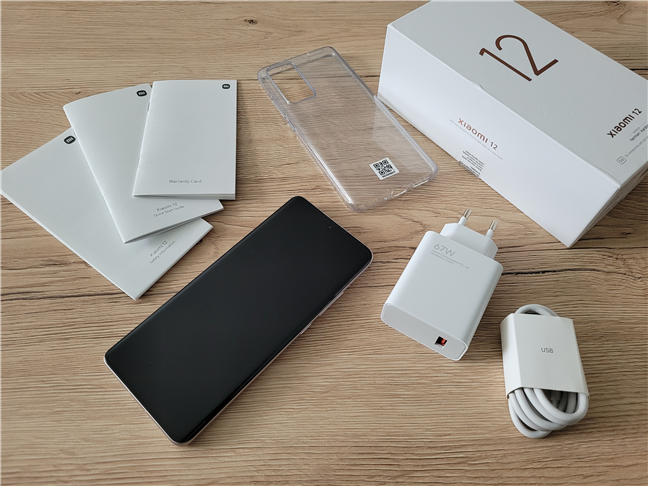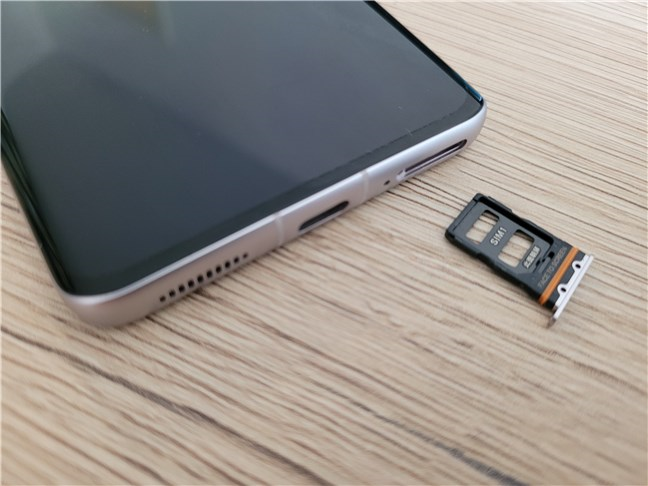
Stores everywhere seem to be filled with devices made and sold by Xiaomi. The company has become one of the biggest players in the tech world, and the Android market is one of its main targets. On top of price-accessible phones, Xiaomi also offers high-end, premium smartphones. And one of the best, at least on paper and in advertisements, is their latest Xiaomi 12. In this review, I will tell you what to expect from it in real life. If you’re curious to learn more, read on:
Xiaomi 12: Who is it good for?
This smartphone is an excellent choice if you:
- Want one of the best Android smartphones available on the market today
- Prefer a more compact smartphone and dislike huge screens
- Are looking for high-end performance, a device that can run any app or game flawlessly
- Don’t like charging your phone for hours - the Xiaomi 12 goes from 0 to 100% in about 40 minutes
Pros and cons
There are a lot of things I like about the Xiaomi 12:
- Its AMOLED screen is very bright, has excellent color reproduction (12-bit), a fast refresh rate of 120 Hz, and supports both HDR10+ and Dolby Vision
- The camera system is top-notch, able to shoot high-quality photographs and videos both in good light and during the night
- The chipset is very powerful and can run any app or game without any kind of issue
- Solid build quality with Gorilla Glass Victus on the display and Gorilla Glass 5 on the back
- It’s a rather compact phone, one that you can use with one hand
- Audio quality is excellent, and the loudspeakers are good
- It charges super-fast, in 40 minutes or so, and the appropriate 67W charger is bundled with the phone
- It also supports fast wireless charging (50 Watts)
Its downsides, in my opinion, are the following:
- It has no telephoto camera, meaning that you don’t get a real optical zoom; 2x-only
- It has no IP rated protection against dust or water
- The battery life could be further improved

Verdict
In my opinion, the Xiaomi 12 is one of the best Android smartphones today. It comes with a high-end Qualcomm chipset that can easily handle anything you throw at it, whether that’s a demanding app or a great-looking, fast-paced action game. 🙂 I love the quality of the photos and videos it shoots, and I like the rather compact size of the phone. It’s a great Android smartphone that you should definitely keep an eye on. The only thing that holds me back from giving it a full five-star rating is the lack of a real telephoto camera.
Unboxing the Xiaomi 12
The Xiaomi 12 Android smartphone arrives in a relatively simple white box that features a minimalistic design. On it, you can see the name of the device and the Mi logo, as well as a couple of important characteristics like the fact that this is a 5G smartphone and that its sound is backed by Harman Kardon. On one of the sides, there’s also a sticker with more technical details like the phone’s name, version, serial numbers, and package contents.

The package of the Xiaomi 12
Inside the box, you’ll find the Xiaomi 12 smartphone (with a pre-applied screen protector), a fast 67W charger and a USB-A to C cable, a transparent silicon cover, a SIM ejection tool, and some documents (user manual, warranty, safety information).

Unboxing the Xiaomi 12
Unboxing the Xiaomi 12 smartphone is a pleasant experience, as the package contains everything you need to get it up and running. I appreciate the fact that, besides the essentials, Xiaomi also bundled a fast charger and a silicon case.
Design and build quality
The Xiaomi 12 is a smartphone that I’d call compact - not too large, but not too small either. Measuring 152.7 mm (6.01 inches) in length, 69.9 mm (2.75 inches) in width, and 8.2 mm (0.32 inches) in thickness, the Xiaomi 12 feels great in your hand. Its body’s ergonomics are almost perfect. The screen glass - Corning Gorilla Glass Victus - is subtly curved on the edges, and its very slim bezels contribute to the sleek design. The smartphone’s weight is definitely noticeable, but I like that: it feels like you get a solid, well-built, and powerful device.
The only thing disrupting the smooth look of the front of the smartphone, but not necessarily in a bad way, is the selfie camera. It's under a tiny hole found at the top center area of the display.

Xiaomi 12 is protected by Corning Gorilla Glass Victus
The speakers are positioned on the top and bottom sides of the phone, not on the bezels. On the top, you also get the infrared sensor towards the right, and what looks like a small microphone together with a sound by harman\kardon inscription.

A look at the Xiaomi 12
On the bottom edge, there’s a speaker, a USB-C port, a small microphone, and the SIM tray. A small detail I like: both speakers have beautifully designed grilles.

A look at the bottom edge of the Xiaomi 12
The back of the smartphone is also covered by glass, but this time it’s Corning Gorilla Glass 5. It’s not glossy glass, though. It’s somehow brushed, which can make you think that it’s some sort of plastic, but it’s not. And that’s actually a good thing, as it’s not a fingerprint magnet at all, and it’s also not going to slide on a table using telekinesis. 🙂

The back of the Xiaomi 12 is protected by Gorilla Glass 5
The main camera system is large, and Xiaomi designed it to have slightly rounded corners but sharp edges too. I like how it looks, but I found it to be quite protruding. Unless you use a smartphone case, the Xiaomi 12 will wobble on any plane surface because of that.

The main cameras system on the Xiaomi 12
Next, the left and right edges of the smartphone. The left one is completely empty. The right one, however, holds the power button and the volume rocker, all towards the top of the smartphone.

The power and volume buttons are on the top-right edge
Last but not least, colors. The Xiaomi 12 can be found in three colors: Gray, Blue, and Purple. The one I tested was the purple one, as you’ve surely noticed in the photos. Here’s what the others look like:

The colors available for Xiaomi 12
I like the way the Xiaomi 12 looks, and I appreciate its compact size and ergonomics. It feels great in hand, and its design, although not revolutionary, is very well thought out.
Hardware specifications
The Xiaomi 12 Android smartphone uses the latest and most powerful mobile chipset today: the Qualcomm SM8450 Snapdragon 8 Gen 1. This SoC (System on a Chip) is built on a 4 nm manufacturing process and bundles an impressively fast octa-core processor (one 3GHz Cortex-X2 core, three 2.50GHz Cortex-A710 cores, and four 1.80GHz Cortex-A510 cores) with an Adreno 730 graphics chip, powerful enough to support Unreal Engine 5! To match all this, Xiaomi also equips its flagship with generous amounts of memory. Xiaomi 12 is available with 8 GB of RAM and fast UFS 3.1, 128 or 256 GB of internal storage space, and there’s also a premium version with 12 GB of RAM and 256 GB of flash storage. For this review, we tested the model featuring 8 GB of RAM and 256 GB of storage.

The specs of the Xiaomi 12
Out of the entire storage space, 230 GB are available to use as you see fit, to fill with apps, games, photos, and whatnot. The rest (about 25 GB) are occupied by the operating system and default apps bundled by Xiaomi. Unfortunately, the smartphone doesn’t include a microSD card slot, so you can’t expand its storage space. That’s not something unexpected, to be honest, as most high-end Android devices don’t have one. On the other hand, the Xiaomi 12 is a 5G smartphone that can use two nano-SIM cards at the same time in dual standby mode.

Xiaomi 12 is a dual SIM Android smartphone
As we’re talking about a high-end device, the Xiaomi 12 smartphone doesn’t compromise on display quality. It uses a relatively compact 6.28 inch AMOLED screen with a resolution of 1080 by 2400 pixels, translating into an excellent pixel density of about 419 ppi. The display offers a high (dynamic) refresh rate of 120 Hz and a touch sampling rate of no more, no less than 480 Hz. These are excellent specs that tell us that the visuals and interaction with the screen will feel natural and smooth. Furthermore, Xiaomi 12’s screen is also very bright (up to 1100 nits), supports HDR10+, and is protected by the latest Corning Gorilla Glass Victus.

Xiaomi 12 features a bright AMOLED display
Moving on to the camera system, here’s what you get on the Xiaomi 12:
- A main 50 MP camera based on the Sony IMX766 sensor with a wide aperture of f/1.9, large 1.0µm pixels, phase-detection autofocus (PDAF), and OIS (Optical Image Stabilization).
- A secondary ultrawide camera 13 MP camera (OmniVision OV13B10) with an f/2.4 aperture and a field of view of 123 degrees.
- A third 5 MP telephoto (2x) macro camera based on the Samsung S5K5E9 sensor.
On the front, the Xiaomi 12 comes with a 32 MP selfie camera with an aperture of f/2.5, also made by OmniVision (OV32B40).
The main camera system can record videos in 8K at 24 fps with HDR, 4K at 30 or 60 fps with HDR10+, and lower resolutions too. If slow-motion is your thing, you’ll be happy to hear that the Xiaomi 12 can shoot them at up to 960 fps in 1080p resolution and up to 1920 fps in 720p.

The cameras on the Xiaomi 12
Autonomy is delivered by a non-removable Li-Po battery with a large capacity of 4500 mAh. Xiaomi 12 supports fast wireless charging at 67 Watts (the appropriate charger is bundled in the package) and is advertised to go from 0 to 100% in 39 minutes. Additionally, the smartphone can also fast charge wirelessly (50W - full charge in 53 minutes) and supports reverse wireless charging (10W). All this is possible thanks to the Power Delivery 3.0 and Quick Charge 4+ technologies used on the Xiaomi 12.

Charging the Xiaomi 12
Communication and connectivity-wise, Xiaomi 12 has everything you’d expect from a high-end Android smartphone. It supports dual-band (2.4 and 5GHz) Wi-Fi 6 or 6e (depending on your region), Bluetooth 5.2, GPS, NFC (also depending on your region), and there’s even an infrared port. The optical fingerprint sensor is found under the screen, and in terms of sensors, you get all the essentials: accelerometer, gyro, compass, and color spectrum.
If you want to see the complete list of features and technical specifications, visit this webpage: Xiaomi 12 - Specs.
On the next page of this review, you can read more about the user experience offered by the Xiaomi 12, its camera quality, performance in benchmarks, and bundled software.


 18.05.2022
18.05.2022 


